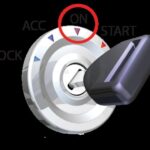Understanding the data your Ford F250’s onboard diagnostics (OBD2) system provides can be crucial for diagnosing issues and maintaining your truck, especially its 4-wheel drive system. This article delves into Ford OBD2 PIDs (Parameter IDs), specifically focusing on those related to the F250 4-wheel drive switch. While a comprehensive list of PIDs is available, interpreting the raw data requires understanding the specific formulas and conversion factors.
Decoding Ford F250 4 Wheel Drive Switch Data
Your F250’s OBD2 system communicates using a series of PIDs, each representing a specific parameter. Accessing these PIDs with an OBD2 scanner provides raw data, often in hexadecimal or decimal format. Unfortunately, a simple list of PIDs without the accompanying formulas for interpretation isn’t very helpful. For instance, knowing the PID for the “4X4L-REQUESTED 4 WHEEL DRIVE INPUT LOW SWITCH” (PID 1101) is only the first step. You need the formula to understand what a returned value of “1” or “0” signifies (typically on/off).
Essential PIDs for F250 4 Wheel Drive Diagnostics
While PID 1101 directly relates to the 4-wheel drive low switch request, other PIDs contribute to a complete diagnostic picture:
- Transmission Selector Position Input Status (PID 11B6, 1151, 16B5): These PIDs provide insight into the gear selected (Park, Reverse, Neutral, Drive) and can help determine if the 4-wheel drive system is engaging correctly in the intended gear.
- Vehicle Speed Sensor (PID 11C1, 1604): Monitoring vehicle speed can be useful for identifying discrepancies between wheel speed and transfer case engagement.
- Engine Speed Based on CKP Input (PID 1165): Engine RPM data can assist in understanding if the engine load corresponds with 4-wheel drive activation.
Finding the Formulas: A Deep Dive
Locating the specific formulas for interpreting Ford OBD2 PIDs can be challenging. Service manuals specific to your F250 model year are the most reliable source. These manuals often contain detailed information on data interpretation and diagnostic procedures. Online forums dedicated to Ford trucks can also provide valuable insights, with experienced users often sharing their knowledge and resources.
Beyond the Switch: A Holistic Approach
Diagnosing 4-wheel drive issues requires looking beyond just the switch. Mechanical components, such as the transfer case, front and rear differentials, and axle actuators, can all contribute to problems. The OBD2 data offers valuable clues, but a comprehensive diagnosis often involves physical inspection and testing of these components.
Utilizing Advanced Diagnostic Tools
For complex issues, advanced diagnostic software, often used by professional mechanics, offers more in-depth analysis capabilities. These tools can provide real-time data logging, graphing, and troubleshooting guidance specific to Ford vehicles.
Conclusion: Empowering F250 Owners
Understanding Ford OBD2 PIDs and their associated formulas is essential for effectively diagnosing and resolving 4-wheel drive problems in your F250. While accessing the necessary formulas can require research, the resulting knowledge empowers you to take a more informed approach to maintaining and repairing your truck. Remember to consult your vehicle’s service manual and leverage online resources for a complete understanding of your F250’s diagnostic data.

